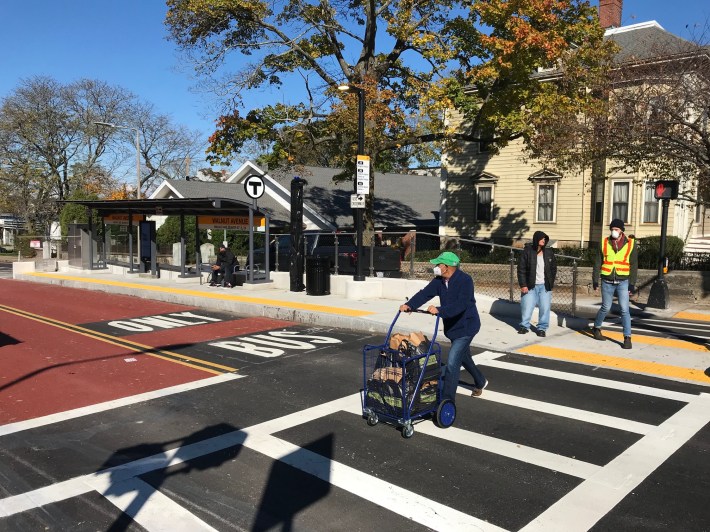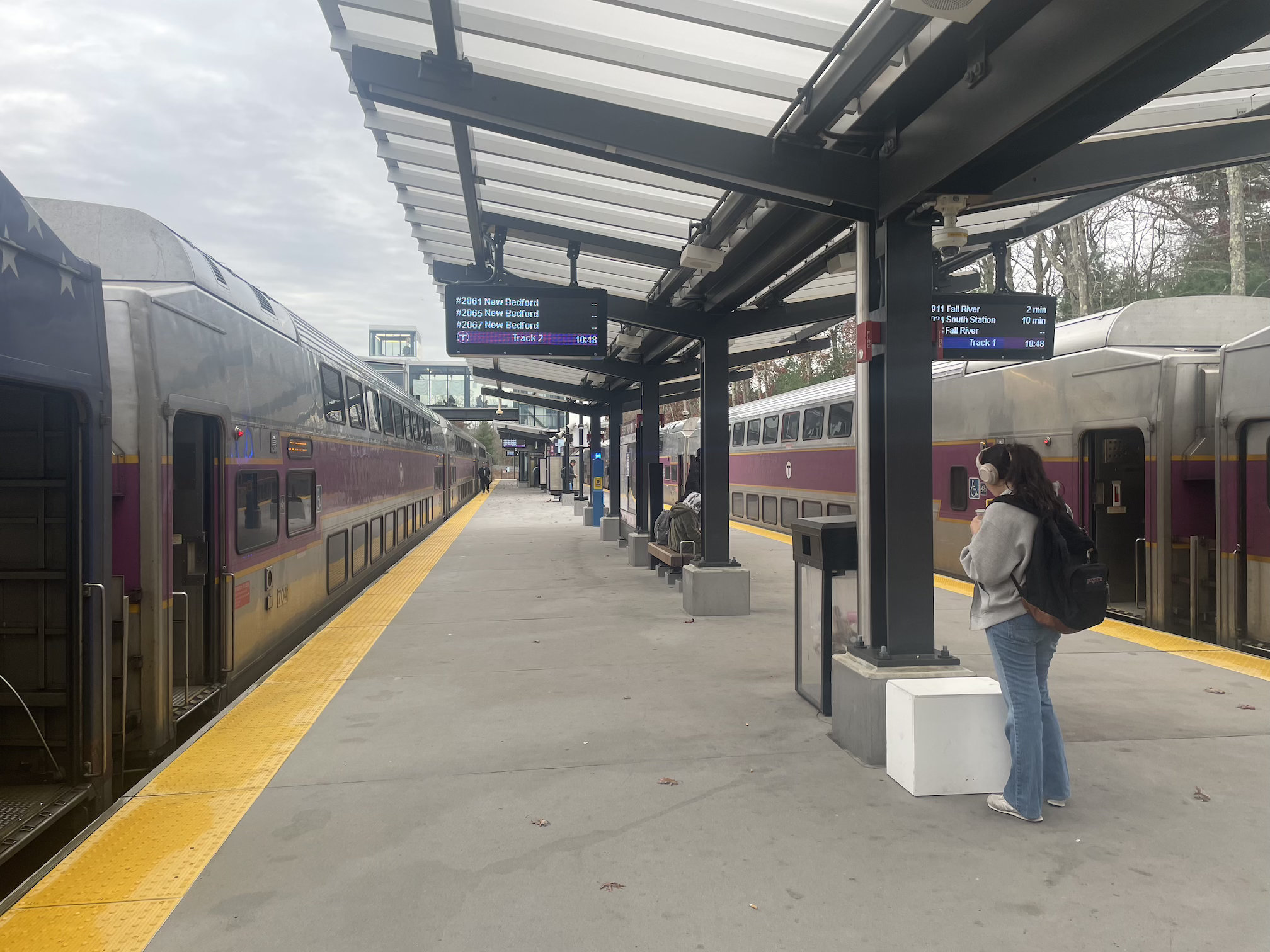Michelle Wu has been sworn in as the city’s next mayor. Wu’s victory is significant on many fronts: she’s a bona fide progressive, the first woman, mother, person of color, and Asian American to be elected as mayor, and she has a track record of backing up her bold ideas with results.
Wu’s signature transportation proposal is fare free public transit, and she describes the policy as a matter of economic and racial justice. But as Wu’s detractors often pointed out during the campaign, the Massachusetts Bay Transportation Authority (MBTA) takes its orders from the state, not the city. Making the T fully fare free may take years of effort and collaboration with the state legislature and governor.
Still, Wu will have broad power to address many of the racial disparities in Boston’s transportation system. While she continues to rally the region toward the longer term goal of free transit, here are some of the ways that the mayor can use the power of City Hall to make Boston’s transportation more equitable right away.
Disincentivize driving by charging fair prices for parking
By some measures, Boston has the worst car traffic in the country. This traffic isn’t just frustrating for drivers: it causes greenhouse gas emissions, increased risk of pedestrian deaths in car crashes, and slows down more sustainable forms of transit including public buses and light rail.
Yet, both the Commonwealth of Massachusetts and the City of Boston effectively subsidize driving. The city and state devote acres of publicly owned and maintained street space to free parking, while failing to charge drivers to recoup the costs that single-occupancy driving imposes on the rest of the population.
This means that low income transit riders who do not own cars are subsidizing car ownership and solo commuting. The state currently invests $64 billion annually in various subsidies to private automobile driving, most of which is paid for by Boston area residents.
The city has the power to change this. The cost of parking, which is zero on many of Boston’s streets, is set by the city. By strategically increasing fees for parking, Mayor Wu can disincentivize driving and create a stream of revenue that can be used to support the city’s sustainable and equitable transportation goals.
Invest in street infrastructure to improve safety in low-income communities of color
Across the country, inequitable city planning decisions have left neighborhoods of color with poorer street infrastructure and more hazards, such as truck routes and major intersections that are difficult to navigate by foot or bike. As a result, more than 6,000 pedestrians and hundreds of cyclists in the U.S. are killed by drivers every year, and fatalities are higher among Latin and African-American populations than among whites.
Boston is no exception. According to city data, 65 percent of sidewalks in Roxbury and Dorchester, predominantly Black neighborhoods, are either in fair or poor condition. The reverse is true in the wealthier and whiter downtown and Back Bay, where 68 percent of the sidewalks are in good condition.
The same goes for cycling infrastructure. Most of the city’s high quality, barrier-protected bike lanes — the ones that provide the most safety to cyclists — are in high-income areas like the North End and Commonwealth Avenue.
City Hall has the power to correct these disparities. Wu can direct the Boston Transportation Department to improve pedestrian and cycling infrastructure in neighborhoods of color, and she does not need approval from the city council or state to do so.
Still, bike lanes and transportation improvements can be contentious because there is a real risk that they will fuel gentrification. This is an important concern, and Wu will need to draw from the deep community relationships she has built throughout Boston to improve transit infrastructure in a way that is guided by community input in the neighborhoods who need it most.
Prioritize and dedicate more city funding to bus lane projects to better serve Black and Brown transit riders
According to the Metropolitan Area Planning Council, Black Bostonians spend 64 more hours stuck in traffic each year than white bus riders, and Latinx riders spend 10 hours more than their white counterparts. This reflects national trends showing a long history of investment in transit that serves white riders, such as commuter rail lines, and disinvestment from buses, which tend to serve communities of color.
Wu already took bold action on her first full day in office with a proposal to expand fare-free service on three key bus routes that serve lower-income communities of color. Another one of the most effective ways Wu can correct the disparities in Boston’s bus service is to create center-running bus lanes in corridors that serve communities of color — essentially devoted express lanes for city buses. A good place to start would be the Silver Line, which runs along Washington Street and serves the majority-Black neighborhood of Roxbury.
In 1987, the state tore down an elevated train line in that neighborhood and promised to replace it, but ultimately broke that promise and left residents with a much slower bus line. Deploying separated, center-running bus lanes along this corridor would be a meaningful step toward restitution and tremendously improve public transportation for residents who commute from the Dudley/Nubian Square Station to downtown.

Boston recently did exactly this on Columbus Avenue, which is expected to significantly speed up service to Roxbury and Jamaica Plain, neighborhoods with a large population of Black residents. The city was able to do this in part because it devoted staff to liaising with the MBTA to make it happen. Investing more city resources into these kinds of roles, especially through bilingual staff who can work with non English-speaking residents and businesses, would allow the city to quickly replicate Columbus Avenue’s success.
Thanks to the MBTA’s own analysis, we already know which bus lines serve the highest number of riders and experience the highest traffic delays. The next step is to speed up bus service in these corridors.
Use the bully pulpit to educate and persuade the public to support bold change
Wu’s advocacy of fare-free transit has already turned a once-radical notion into a real possibility. Even when conventional political wisdom held that the MBTA had no choice but to increase fares, Wu championed the idea and has since backed it up with solid research, a successful pilot of a fare-free bus in Boston undertaken during Mayor Kim Janey’s administration, and an expansion of free bus service announced on her first full day in office.
As Mayor, Wu will have a much larger megaphone that she can wield to lead the city toward the change it so desperately needs, and evidence shows that it will work. As Harvard Kennedy School professor Justin de Benedictis Kessner wrote in a recent white paper, “research shows that people are willing to take on the relatively small costs of these transportation improvements if their leaders show them how this can benefit the city overall.”
Jonathan Timm is a graduate student who focuses on transit and housing equity at the Harvard Kennedy School. Prior to HKS, he served as the director of policy and communications for NY State Senator Zellnor Myrie and reported on labor policy for The Atlantic. He is currently publishing a set of case studies on permanent supportive housing programs for the California Department of Housing and Community Development. This piece is a co-publication of the Harvard Kennedy School Progressive Policy Review (PPR). PPR thanks Justin de Benedictis Kessner and Kathryn Carlson for their helpful comments.






